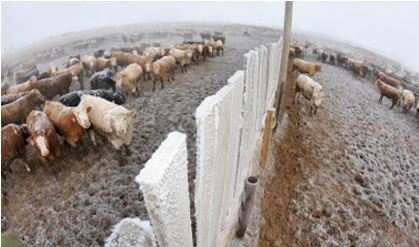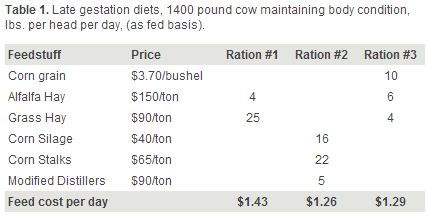



Is Hay Still the Best Choice to Winter Cows?
Using more corn this winter could bring savings this year, according to cow/calf specialist Warren Rusche in an analysis of the price of hay against the much cheaper corn.The feed cost environment for 2013-2014 is dramatically different compared to last year. Corn and corn-derived feeds such as distiller’s grains and silage are only about half the cost of one year ago.
Hay and roughage costs are lower as well, but on a percentage basis the price decline has not been as dramatic as compared to corn prices. Is there an opportunity to exploit these differences in feed prices to reduce winter feed expenses?
Three different rations for 1400 pound cows in late gestation are shown in Table 1. The rations were formulated to meet protein requirements and at least maintain body condition. Ration #1 is a traditional hay based diet using alfalfa hay (19 per cent CP) and grass hay (8 per cent CP).

Ration #2 consists of corn silage, corn stalks and modified distiller’s grains. Ration #3 is a limit-fed diet using 10 pounds of hay (alfalfa and grass) combined with 10 pounds of corn per head per day. The prices are based on published price data from SD feed markets in late November.
Using these prices, diets utilizing corn or corn-derived feeds are more cost effective compared to diets relying completely on hay. Of course every situation is different and hay costs in some markets may not be as high as the values used here. It should be noted that the corn price is for dry corn. In some cases there may be an opportunity to utilize wetter corn that would otherwise be subject to discounts and reduce costs further.
Implementing some of these strategies requires limiting the cows’ feed intake below what their appetite would be normally. In order to do that successfully, there are some management factors that need to be considered.
Some of these include:
- Diets should be based on actual nutrient analyses.
- Gradually adapt cattle to diet changes, especially if high-starch feeds are used.
- Proper bunk management is extremely important to avoid digestive upsets.
- Allow plenty of room at the bunk and in the lot (at least 30 inches of bunk space and 500 ft2 per cow).
- Limit-fed rations will meet the cows’ nutrient needs, but won’t satisfy their appetite. Strong fences are essential.
- Just like under more traditional management systems, body condition needs to be monitored to make sure that the cattle are on track to meet production goals.
February 2014



